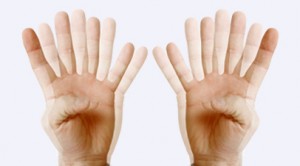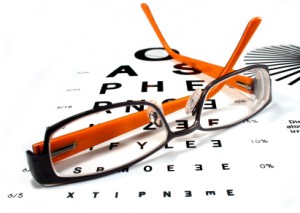This section will discuss the question: what information does your prescription for new glasses contain? and what makes one pair of glasses different from another?
Firstly, a short description of the glasses themselves: each one of the lenses is characterized by a number that is also known as “the corrective power” of the lens and expressed in “diopters.” This corrective power can be of the “plus” type, or of the “minus” type. The higher the number (regardless of whether it’s a plus or a minus), the thicker the lens will be, and likewise, the higher the number, that eye without the help of the lenses will perceive a blurrier picture (will see less).
In addition to the corrective power of glasses referred above, there is also the possibility to correct ‘astigmatism’, also known as ‘cylinder’. Astigmatism and cylinder are rather complicated principles in optics, but I will do my best to explain them in a few sentences.
Cylinder and astigmatism are essentially synonyms of sorts, two ways to describe the same optic phenomenon that creates distortion of a picture as seen by the viewer. ‘Astigmatism’ of the eye (which is usually the result of a problem in the cornea) is corrected by a ‘cylinder’ which resides within the glasses, such that one cancels out the other. Thus, the small distortion of the cornea is neutralized by an intentional distortion that is applied to each lens of your glasses. Stated otherwise, astigmatism is the problem, while cylinder is the solution.
The strength of the cylinder (also called the cylindrical correction) is measured in ‘diopters’. Note that it is often confusing since both the cylinder as well as the power of the glasses (also called ‘sphere’) are both measured in units of ‘diopters’). However, in addition to the strength of the cylinder, there is significance to the direction (orientation) of the cylinder: is the cylinder axis oriented horizontal, vertical, or diagonal. The direction (known also as ‘the axis’) of a cylinder is measured in degrees. For eyes that require glasses the prescription of that particular pair of glasses is described using the amount of corrective power (described in diopters) and in addition, in many cases, there is also a component of ‘cylinder’.
The optical principles which underlie the concepts of ‘astigmatism’ and ‘cylinder’ are indeed quite complicated. In summary, every lens in each pair of glasses consists of 3 parameters which allow them to be appropriate for a particular eye and which differentiate them from a lens meant for any other eye. Since it is necessary that all three components be fitted for a particular eye (it is not enough that two out of three are precise), it is not difficult to understand why once every few years it may be necessary to go for a new fitting of lenses for your glasses. In this way, each eye can achieve the best possible visual acuity.
In addition to the corrective power of the lenses and to the amount of cylinder, there are a few more technical characteristics of a pair of glasses. These characteristics also need to be fit to the person who wears the glasses in order for the glasses frame to fit comfortably.
These components include:
The width of the frame and size of the lenses need to be appropriate for the width of the face. The size, or height, of the lenses is also influenced by fashion and personal preference. Today there is a fashion tendency toward smaller and smaller lenses.
The distance between the centers of the lenses has to be suited to the distance between the pupils. This is one of the parameters that the optometrist measures during the optometric exam. This distance between the center of each lens, is called the papillary distance (‘PD’ for short) and refers to the fact that each person’s eyes are set a certain distance apart (the distance between the center of your pupils) and this needs to be reflected in how your glasses are made (how the lenses are ‘cut’).
The length of the earpieces needs to be appropriate for the size of the person’s head so that the earpieces will sit comfortably on the ears. It is amazing how neglected this parameter is, particularly because fixing this parameter involves changing the side pieces (usually to shorten them). In theory, one can compensate, at least partially, for this by bending the end of the earpiece (the part that sits on the ear). However, earpieces that are not fitted properly can negatively affect the comfort of the pair of glasses and even cause them to slip from their place often and thus necessitate being pushed back into place (by pushing the bridge back up towards the nose).
There are glasses with or without frames (or with half-frames): these are characteristics that do not alter or influence the function of the glasses as long as the frames are sturdy and stable.
The material that the lenses are made of: glass, plastic, and glass (or plastic) with a high refractive index (which allows for thinner lenses for a similar prescription). Today the vast majority of lenses are made of plastic which is much lighter, cheaper, but on the other hand, is also more prone to scratches (and therefore there is a special coating applied, which protects against scratches).
The materials which the frame can be made of include: various metals, titanium and plastic. Each one has different characteristics, advantages, and disadvantages. It is important to note that it is best for people who have allergies to metal (usually this is an allergy to nickel) to steer clear of metal frames. It is possible for you to know if you have such an allergy if a rash appears when your skin comes in contact with metal, such as earrings, watches, the clasp of a watch, or rings that are not made of silver, titanium or gold (three metals to which people do not develop allergies).
Coating of the lenses: there are a few different types of coatings that can be applied to the lenses. There is a coating meant to protect plastic lenses from scratches; an anti-reflex coating (which prevents seeing various light reflexes when looking at a person). Also, there are various coatings to darken the lenses (to turn them into sunglasses). These darkening coatings may be permanent or changing: lenses that turn lighter in the dark and darker in well-lit (sunlight) conditions.
Additional information can be found in the following pages, which are dedicated to different topics related to glasses and the need for wearing them:
Visual Disturbances that Require Glasses
Myopia – Short-sightedness
Hyperopia – Far-sightedness
Presbyopia (difficulty seeing for near)
The Need for Reading Glasses


